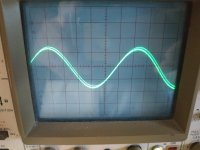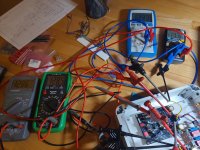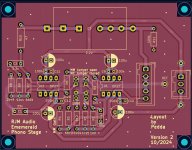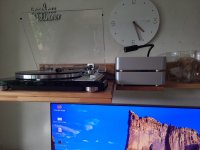Hi....
I found a stupid mistake i made in the schematic and afterwards in the layout then.😡
There was a connecting from the rails to the testpoints. I cut this little track connection with a cutterknife. Kenta16807 gave the right tip 👍
I compared the original schematic with mine and took another look the original layout, using a gerber viewer, and found out my stupid mistake.
I hope the emerald boards are working now without a problem. It was too late yesterday evening and i will test the boards soon...
I will report...
Thank you very, very much...
Greets
Peter
I found a stupid mistake i made in the schematic and afterwards in the layout then.😡
There was a connecting from the rails to the testpoints. I cut this little track connection with a cutterknife. Kenta16807 gave the right tip 👍
you seem to have a short here or something wrong in Q1 and Q2.
I compared the original schematic with mine and took another look the original layout, using a gerber viewer, and found out my stupid mistake.
I hope the emerald boards are working now without a problem. It was too late yesterday evening and i will test the boards soon...
I will report...
Thank you very, very much...
Greets
Peter
So, a bad solder joint and a short to earth on the housing have cost me some time.Now I have finished the pre-amp. It works great on one channel, on the other it sounds as if the tweeter is defective.
The OPAs are all OK, the jumper also works. I suspect an electrolytic capacitor is defective. If the voltage after the R11 is correct and the OPAs are OK, there it could only a capacitive out of range - is that correct?
I have now installed the LT1007 and the NE5534 and what does it do, or rather what is noticeable?
1. dead silence - whether MC or MM, no background noise. I liked that so much with the VSPS, and it's the same here. Maybe it's the circuit design? Very good in any case!
2. channel separation: subjectively very high, i.e. a large stage
3. fundamental: superior bass, delicious.
MC: Very very nice.... I like it.
Richard, Thanks for the Emerald!
"what does it do, or rather what is noticeable?"
The op-amps do sound different, but it's subtle - some are clear, some are crunchier, some are bright, some less so. According to my tests, the OPA27 is the best here, but feel free to experiment.
The op-amps do sound different, but it's subtle - some are clear, some are crunchier, some are bright, some less so. According to my tests, the OPA27 is the best here, but feel free to experiment.
Hi....
I have a question aubout the on board supply....
The voltage on my boards is drifting a little bit up and down in mV. Is this the normal case ? It takes a little time to reach the adjusted +-14 volts after power on.
For example...+13,99 volts/-14,21 volts if i power on....after a few minutes the voltage on both boards is equal and i get 14,16 volts with a trnd to lower on each rail, but thats not what i have adjusted in the evening.
Thats not dangerous to the OPA, but i find it a bit strange.
As wrote here in the thread....using one pot give different voltages on the boards. I had one board wtih 13,34 volts and the second with 12,85 volts. Using two pots you can adjust equal voltages for the two boards. On my boards i designed the layout for two pots.
Is there any reason not to use a extern power supply with two regulators ? I am thinking about the "denoiser" from Elvee. Therefor i made a new pcb layout yesterday evening.
Greets
Peter
I have a question aubout the on board supply....
The voltage on my boards is drifting a little bit up and down in mV. Is this the normal case ? It takes a little time to reach the adjusted +-14 volts after power on.
For example...+13,99 volts/-14,21 volts if i power on....after a few minutes the voltage on both boards is equal and i get 14,16 volts with a trnd to lower on each rail, but thats not what i have adjusted in the evening.
Thats not dangerous to the OPA, but i find it a bit strange.
As wrote here in the thread....using one pot give different voltages on the boards. I had one board wtih 13,34 volts and the second with 12,85 volts. Using two pots you can adjust equal voltages for the two boards. On my boards i designed the layout for two pots.
Is there any reason not to use a extern power supply with two regulators ? I am thinking about the "denoiser" from Elvee. Therefor i made a new pcb layout yesterday evening.
Greets
Peter
Attachments
@Kleinhorn As you note, rocksteady output voltages are unnecessary for this circuit, and the S-reg is not designed to provide them.
The idea is to provide low noise and low impedance, the actual output voltage will fluctuate a little with temperature, which is especially noticeable on a cold start.
You are welcome to use whatever power supply / regulation circuit you prefer. Will it sound better? I suggest you might want to compare before deciding.
The idea is to provide low noise and low impedance, the actual output voltage will fluctuate a little with temperature, which is especially noticeable on a cold start.
You are welcome to use whatever power supply / regulation circuit you prefer. Will it sound better? I suggest you might want to compare before deciding.
Hi rjm,
you are right. There is no need to use a different supply. My Emerald is working and the sound is very good, like it more than my Supra 2 from Elektor. I am using a grado silver, MM, and had to adjust the gain a bit. In the moment i use (R4) 470 ohm, 1 k was not loud enough....i think i change to 330 ohm at last.
No backround noises, clear sound. I will hear with the OPA27 a time and then try other ic's.
Thank you for this nice Phono Pre, for your delevopment and your support...
Best regards
Peter
you are right. There is no need to use a different supply. My Emerald is working and the sound is very good, like it more than my Supra 2 from Elektor. I am using a grado silver, MM, and had to adjust the gain a bit. In the moment i use (R4) 470 ohm, 1 k was not loud enough....i think i change to 330 ohm at last.
No backround noises, clear sound. I will hear with the OPA27 a time and then try other ic's.
Thank you for this nice Phono Pre, for your delevopment and your support...
Best regards
Peter
Attachments
Hoping for help troubleshooting a new issue for me.
I've been running the emerald for close to two years now and recently had static hiss occur in one channel. I still get music through if I play a record but the hiss overpowers it, the other channel is unaffected. I switched cables from TT to the Emerald, no change, but when I switched the cables on the output from the Emerald the sound switched speakers, so I'm confident I've identified the issue and board.
I've swapped ICs from one channel to the other, no change. I've checked my voltages at V+ and V-, no issue there either. I have a super cheapo oscilloscope from Amazon that I kind of understand, when I place it in AC mode I can see a much noisier signal occurring in the feedback loop of IC2 through to C3. I swapped out C3 for another 2.2uF I had in my parts bin and no change.
Any ideas on more precise measurements I can take to try and isolate the problem? I find it odd that something has popped up now after hours of great playback and no issue as of a month or two ago.
I've been running the emerald for close to two years now and recently had static hiss occur in one channel. I still get music through if I play a record but the hiss overpowers it, the other channel is unaffected. I switched cables from TT to the Emerald, no change, but when I switched the cables on the output from the Emerald the sound switched speakers, so I'm confident I've identified the issue and board.
I've swapped ICs from one channel to the other, no change. I've checked my voltages at V+ and V-, no issue there either. I have a super cheapo oscilloscope from Amazon that I kind of understand, when I place it in AC mode I can see a much noisier signal occurring in the feedback loop of IC2 through to C3. I swapped out C3 for another 2.2uF I had in my parts bin and no change.
Any ideas on more precise measurements I can take to try and isolate the problem? I find it odd that something has popped up now after hours of great playback and no issue as of a month or two ago.
@Calvdart
Most likely culprit is a cold solder joint. This oxidize over time and eventually fail. First thing I'd do is go in with the soldering iron and reflow all the connection involving signal wires to and from the boards, including at the RCA jacks. If that doesn't work I'd bull the board out and reflow the solder at all the pads for the through hole components.
/R
Most likely culprit is a cold solder joint. This oxidize over time and eventually fail. First thing I'd do is go in with the soldering iron and reflow all the connection involving signal wires to and from the boards, including at the RCA jacks. If that doesn't work I'd bull the board out and reflow the solder at all the pads for the through hole components.
/R
Hi ,
i had heard for a few days wit 2xOP27, but found that the midbass is to muddy (to my ears). I tried different OPA's now...the LME49710 on the first stage is my choice in the Moment. It let the sun shine....
Mabe with a different MM cartridge you get an other result. But i don't think so...
If you hold a LME49710 in stock, perhaps try it...
Peter
i had heard for a few days wit 2xOP27, but found that the midbass is to muddy (to my ears). I tried different OPA's now...the LME49710 on the first stage is my choice in the Moment. It let the sun shine....
Mabe with a different MM cartridge you get an other result. But i don't think so...
If you hold a LME49710 in stock, perhaps try it...
Peter
My evaluation was with the DL103. Results may be slightly different for MM carts, and indeed are expected to be. Also, the op amp balances/complements the sound of the coupling cap, so what component you use there will affect your choice of op amp.
People have said good things about the LME49710, and the point is to find something you're happy with.
People have said good things about the LME49710, and the point is to find something you're happy with.
It was coincidence. I have the LME49710 in stock from the past. Now the LME49710/49740 are obsolet. If you can get an original the price has exploded, 16 Euro is realy heavy.
I tried other OPA like LT1028, NE5534, OPA134 and have ordered different OPA like OPA627 or OPA1611, waiting for delivery. Using a MM cartridge the LME was the best choice for my ears until yet. For MC i dont know... I will see. I am a little surprised using 100 Ohm for a Denon DL103. I think 470 ohm will be the better choice for the DL103 without R.
I will try 470 Ohm for R2 to get a gain of 59 dB. I changed the other resistors to their values 68,1 Ohm, 1K in the worksheet....
Playing around...
The Emerald is a nice gift....🙂
Best regards
Peter
I tried other OPA like LT1028, NE5534, OPA134 and have ordered different OPA like OPA627 or OPA1611, waiting for delivery. Using a MM cartridge the LME was the best choice for my ears until yet. For MC i dont know... I will see. I am a little surprised using 100 Ohm for a Denon DL103. I think 470 ohm will be the better choice for the DL103 without R.
I will try 470 Ohm for R2 to get a gain of 59 dB. I changed the other resistors to their values 68,1 Ohm, 1K in the worksheet....
Playing around...
The Emerald is a nice gift....🙂
Best regards
Peter
Hi...
A last question, i hope. The Denon DL103 is a bit to quiet at the Emerald Phono, compared with my other sources. With a MM cartrigde there was no problem, i lowerd R4 1k to 330 ohm.
The worksheet allows to set 33 Ohm or 22 ohm instead of 68,1 ohm. I have set an input load resistor of 1k (R2), as in the measurement of the DL 103 shown. R4, 1 k and R5 1,5k i have not changed until yet. Can i get any trouble to lower R3 to 33 or 22 Ohm and R4 to 330 Ohm ?
Greets
Peter
A last question, i hope. The Denon DL103 is a bit to quiet at the Emerald Phono, compared with my other sources. With a MM cartrigde there was no problem, i lowerd R4 1k to 330 ohm.
The worksheet allows to set 33 Ohm or 22 ohm instead of 68,1 ohm. I have set an input load resistor of 1k (R2), as in the measurement of the DL 103 shown. R4, 1 k and R5 1,5k i have not changed until yet. Can i get any trouble to lower R3 to 33 or 22 Ohm and R4 to 330 Ohm ?
Greets
Peter
@Kleinhorn
The recommended load for a DL103 is 100 ohms, not 1000. This is R2.
Adjust R3 to change the gain for the MC setting. It's 68 ohms by default, reduce to 33 will double the gain (+6 dB). If you need more than that the issue is better addressed at the system level, as this is already more than a typical MC stage would provide.
Don't change R4 or R5.
The recommended load for a DL103 is 100 ohms, not 1000. This is R2.
Adjust R3 to change the gain for the MC setting. It's 68 ohms by default, reduce to 33 will double the gain (+6 dB). If you need more than that the issue is better addressed at the system level, as this is already more than a typical MC stage would provide.
Don't change R4 or R5.
Close, the minimum recommended load are 100 ohms. 😉The recommended load for a DL103 is 100 ohms, not 1000.
It's the same on the 103R I have.
Tested and documented response from Denon is at 47K.
Ran mine at 47K briefly, thought it sounded a bit more 'open' if that makes sense...YMMV
I have changed R3 yesterday for two times. 33 Ohm was too much, 39 Ohm is the better choice, but i will went to 47 Ohm. I think the difference between my sources is gone then. For R2 i used 100 ohm and took 1K out. The result is 1K is the better input load, makes the sound more open.
I had read about this in other threads, in other forums as in the Analogue Audio Association Forum or DIY Hifi Forum. I can say they are right.
Greetings
Peter
I had read about this in other threads, in other forums as in the Analogue Audio Association Forum or DIY Hifi Forum. I can say they are right.
Greetings
Peter
I remember it was 100 ohms for fullness, higher for airiness, so that tracks. Depends on your system/taste.
47 ohms gives you +3dB, bringing the total up to around 60 dB. Sounds about right.
47 ohms gives you +3dB, bringing the total up to around 60 dB. Sounds about right.
- Home
- Source & Line
- Analogue Source
- RJM Audio Emerald Phono Stage Help Desk



